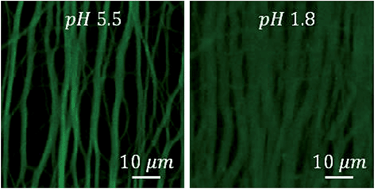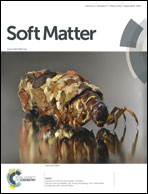Electrospinning polyelectrolyte complexes: pH-responsive fibers†
Abstract
Fibers were electrospun from a solution comprised of oppositely charged polyelectrolytes, in efforts to achieve highly confined macromolecular packaging. A stoichiometric ratio of poly(allylamine hydrochloride) and poly(acrylic acid) solution was mixed in an ethanol–water co-solvent. Differential scanning calorimetry (DSC) analysis of electrospun fibers demonstrated no indication of glass transition, Tg. Infrared spectroscopy (FTIR) analysis of the fibers as a function of temperature, demonstrated an amidation process at lower temperature compared to cast film. Polarized FTIR indicated a preference of the functional groups to be perpendicular to the fiber axis. These results imply formation of mixed phase fibers with enhanced conditions for intermolecular interactions, due to the highly aligned and confined assembly of the macromolecules. The tunable intermolecular interactions between the functional groups of the polyelectrolytes, impact pH-driven, reversible swelling–deswelling of the fibers. The degree of ionization of PAA at pH 5.5 and pH 1.8 varied from 85% to 18%, correspondingly, causing transformation of ionic interactions to hydrogen bonding between the functional groups. The chemical change led to a massive water diffusion of 500% by weight and to a marked increase of 400% in fiber diameter, at a rate of 0.50 μm s−1. These results allow for manipulation and tailoring of key fiber properties for tissue engineering, membranes, and artificial muscle applications.


 Please wait while we load your content...
Please wait while we load your content...